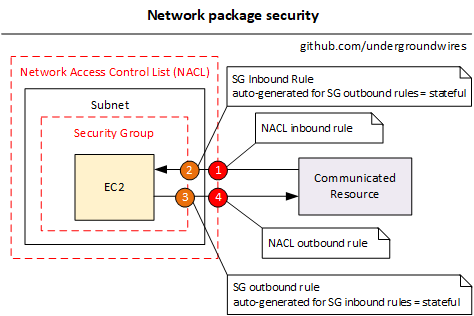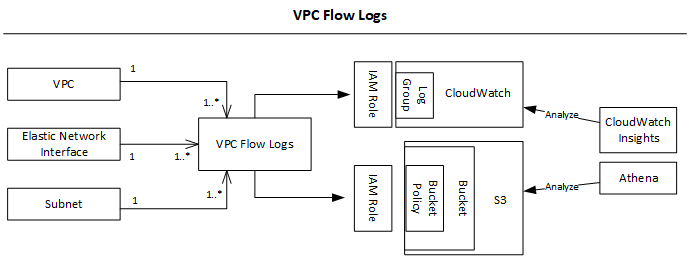Books / AWS in Bullet Points - Exam Prep Study Notes / Chapter 14
Networking - VPC
VPC
- VPC = Virtual Private Cloud
- ❗ You can have max 5 VPCs in a region - soft limit
- ❗ Your VPC CIDR should not overlap with your other networks (e.g. corporate)
- VPC can be deployed in to shared hardware (default) or dedicated hardware (costly).
- A VPC is multi AZ but deployed into a single region.
- IP addressing in VPC
- Only private IP ranges as it’s private.
- Can add new ranges as IPv6 or IPv4 CIDR after creating the VPC.
- ❗ Max CIDR per VPC is 5.
- ❗ For each CIDR:
- Min size is /28 = 16 IP addresses
- Max size is /16 = 65536 IP addresses
- Default VPC in
- All new accounts have a default VPC in each region.
- It comes with
- Subnet per AZ
- Internet gateway
- Network ACL: allows all inbound and outbound traffic
- Main route table that routes VPC CIDR range to local and
0.0.0.0/0to Internet gateway. - Security group denying inbound from internet, allowing outbound to internet.
- Instances get public & private IPv4 + hostnames
- In custom VPC = private IP + hostname, and public depending on settings
- VPC Components
- DNS Resolution in VPC
enableDnsSupport(DNS Resolution setting)- Helps decide if DNS resolution is supported for the VPC
- If true (default), queries the AWS DNS server at
169.254.169.253
enableDnsHostname(DNS Hostname setting)- If True, assign public hostname to EC2 instance if it has a public IP
- Private DNS is always assigned regardless true or false
- False by default for newly created VPC, True by default for Default VPC
- Won’t do anything unless
enableDnsSupport=true
- If True, assign public hostname to EC2 instance if it has a public IP
- 📝 Private DNS + Route 53: enable DNS Resolution + DNS hostnames (VPC) DNS domains and their subdomains keeping the resources masked from the Internet.
- ❗ Multicast is not supported.
- Multicasting: one or more sources can transmit network packets to subscribers
- 💡 You can enable virtual overlay network
- It’s IP level multicast across network fabric unicast IP routing supported by VPC.
Package security

Network Access Control Lists (NACLs)
- Like firewall which control traffic from and to subnets.
- Deployed into VPC
- NACLs are stateless filtering rules
- Stateless because if an ingress traffic is allowed, the response is not automatically allowed unless explicitly allowed in the rule for the subnet.
- Applied at the subnet level and applies to every resource deployed to the subnet
- A subnet can have only one NACL
- Same NACL can be applied to multiple subnet
- NACL Rules
- Rules are numbered and evaluated in order
- Starting with the lowest numbered rule
- E.g.
#100 ALLOW <IP>override#200 DENY <IP> - Last rule is an asterisk (*) and denies a request in case of no rule match
- 💡 AWS recommends adding rules by increment of 100 for leaving some places for future rules
- E.g.
- Default NACL allows everything outbound and everything in bound
- ❗ Newly created NACL will deny everything
- Ephemeral ports
- An ephemeral port is a short-lived transport protocol port for Internet Protocol (IP) communications.
- Ephemeral ports are allocated automatically from a predefined range by the IP stack software.
- Allows returning traffic to clients
- Range varies depending on the client’s operating system
- E.g. Linux 32768 - 61000, Elastic Load Balancing 1024 - 65535, Windows Server 49152 - 65535
- Different OS and different applications will pick different ports.
- To cover the different types of client that might initiate traffic to public-facing instances in your VPC, you can open ephemeral ports 1024 - 65535 (NAT Gateway ports) to outbound connections.
- You should deny malicious ports
Security Groups
- stateful e.g. if inbound rule passes, outbound rule passes as well
- Applied at the EC2 instance level
- More specific: Elastic Network Interface (ENI) level
Security Groups vs Network Access Control Lists
-
Differences
Attribute Security Group NACL Execution Instance (ENI layer) Subnet boundary State Stateful (one direction rules) Stateless (must configure both inbound & outbound) Life scope VPC (any AZ or Subnet) Subnet Scoped (must be attached explicitly to subnets) Applies to Instance only All instances in the associated subnets Rules Allow rules only Allow and Deny rules both Rule order Evaluate all rules as group In number order, if hit a match, does not check other rules -
Reasons to use both:
- SG have soft limit of 50 rules.
- More security layers = better, protection against misconfigurations
- Segregation of responsibilities, Network Admins for NACLs, SGs for Server Admins.
VPC Peering
- Connect two VPC, privately using AWS network
- Make them behave as if they were in the same network
- ❗ Unsupported VPC Peering Configurations
- Must not have overlapping CIDR
- VPC Peering connection is not transitive
- Must be established for each VPC that need to communicate with one another
- E.g. if a <-> b and b <-> c it does not mean a <-> c
- Edge to Edge Routing Through a Gateway or Private Connection
- E.g. corporate network through Direct Connect, Internet through internet gateway, internet in subnet through NAT, VPC endpoint to an AWS and Ipv6 ClassicLink connection
- You can do cross-account & cross-region VPC peering
- You must update route tables in each VPC’s subnets to ensure instances can communicate,
- The accepter VPC must “accept” the peering connection,
- Flow in console:
- Go to VPC -> Peering connections -> Create peering connection
- Define requester & accepter VPC.
- Go to accepter VPC -> right click -> accept request
- In each VPC, route CIDR range of other VPC to the Peering Connection
VPC Endpoints
- Allow you to connect to AWS Services using AWS network instead of the public www network.
- They scale horizontally and are redundant
- They remove the need of IGW, NAT etc… to access AWS Services
- PrivateLink = VPC Endpoints
- Two types of endpoints:
- Interface
- Provisions an ENI (Elastic Network Interface with private IP address) as an entry point
- Must attach security group
- Most AWS services
- Services hosted by other AWS customers and partners in their own VPCs
- AWS marketplace services
- You can see the resource but can’t manage
- You have to define which subnets the endpoint will live.
- Ensure that the attributes
Enable DNS hostnamesandEnable DNS Supportin VPC are set to true.
- Gateway
- S3 and DynamoDB only
- In route table it provisions a target for internal S3/DynamoDB to the VPC endpoint automatically.
- Ensure resources accessing S3 (e.g. EC2) has IAM role to the resource
- Interface
- In case of issues:
- Check DNS Setting Resolution in your VPC
- Check route tables
- Ensure you’re trying to reach endpoint within same region
Flow Logs

- Capture information about IP traffic going into your interfaces:
- VPC Flow Logs
- Subnet Flow Logs
- Elastic Network Interface Flow Logs
- Can capture from managed services such as ELB, RDS, ElastiCache, Redshift, WorkSpace
- Helps to monitor & trouble shoot connectivity issues & security attacks
- Can log ACCEPT traffic, REJECT traffic or both.
- Data is sent to either S3 or CloudWatch Logs
- 📝 You can query VPC flow logs using Athena on S3 or CloudWatch Logs Insights
- Flow Log Syntax
<version>,<account-id>,<interface-id>,<srcaddr>,<dstaddr>,<srcport>,<dstport>,<protocol>,<packets>,<bytes>,<start>,<end>,<action>,<log-status><srcaddr>and<dstaddr>help identify problematic IP<srcport>and<dstport>help identify problematic ports<action>: success or failure (accept / reject) of the request due to Security Group / NACL<log-status>:OK-> logging normally,NODATA: No network traffic to or from during capture window,SKIPDATA: Skipped during capture windows because of e.g. capacity constraint or an internal error.
- Can be used for analytics on usage patterns, or malicious behavior
- ❗ You cannot allow it in peered VPCs unless the peer is in your account.
- ❗ Does not monitor: instances when they contact Amazon DNS server, Windows license activation, to and from
169.254.169.254instance metadata, DHCP, to reserved Id address for the default VPC router.
Connect & manage private instances
- Bastion Host (Jump Boxes)
- Designed to withstand security attacks and usually hosts only a proxy server
- Used to administer EC2 (SSH/RDP)
- Does not replace NAT gateway/instance as they are not used for SSH/RDP but to provide internet traffic to private subnets.
- The bastion is in the public subnet /(DMZ) which is then connected to all other private subnets
- 💡 Small EC2 instances is enough as it does not require much processing power.
- Bastion Host security group must be tightened
- 📝💡 Make sure the bastion host only has port 22 traffic from the IP you need, not from the security groups of your instances
- SSM Session Manager
- Systems Manager allows you to remotely execute commands on managed hosts without using a bastion host
- Way to go in future and will replace bastion hosts
- You don’t have to manage SSH keys.
- Free & serverless AWS managed service
- Requires an IAM policy that allows users or roles to execute commands remotely.
- Agents require an IAM role and policy that allow them to invoke the Systems Manager service.
- The Systems Manager agent is an open-source executable that runs on supported versions of Linux and Windows
- Systems Manager immutably logs every executed command
- Systems Manager allows you to remotely execute commands on managed hosts without using a bastion host





